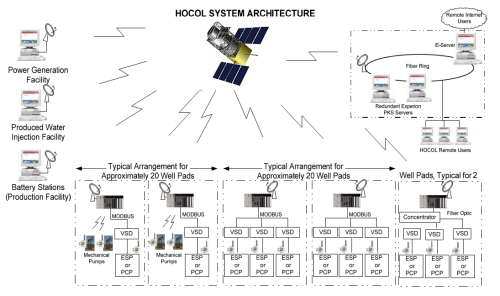The Energy Consulting Group
Business strategy for upstream oil and gas producers and service companies
|
Digital Oil Field:
Having Your Cake and Eating It
In Colombia, an operator wanted to improve the economic performance of four remote, high volume oil and gas fields by increasing oil production, more fully utilizing the in-field workforce of about 90 people, lowering well intervention costs, and improving safety and environmental compliance. Usually, trying to optimize on any one of these measures would reduce the performance of at least one and perhaps all of the other areas, but not with the digital oil field. In fact, using the hi-frequency, hi-density, real-time capabilities of the DOF concept, the operator in this example was able to attain all four of the goals simultaneusly at a reasonable cost. |
|
|
The core technology architecture is laid out
in the following schematic: Schematic 1 |
|
|
Process Improvements Lead to More Production and Safer Operations By enhancing the ability of the field operators to remotely
monitor the status of the production and production equipment for
which they are responsible, the company found they
undertook less “windshield” time, and spent more time diagnosing problems
and devising ways to improve the situation. This resulted in better
decisions, leading to better operational performance, especially
for equipment uptime.
In turn, the improved uptime, increased production, and reduced
maintenance costs. In addition, the operator believes that this way of operating is
better for field personal. In other venues, the author has found
that on a time weighted basis, traveling to and from, and within the
field is amongst the most hazardous activities that field
personnel do. Given that,
any reduction in windshield time results in an inherently more safe
operation. In addition to providing the field personal with better, and
more timely data, the satellite communications system allowed
performance and status data
from the field’s ESPs, and PCPs to be remotely delivered to third
party experts based thousands of miles away, who then used the real
time date to optimize the artificial lift on a system basis,
starting deep in the reservoir (pressure build-up or draw down
information), across the sand face (determine degree of skin, if
any, and whether a well stimulation treatment might be warranted),
through the pump (how efficient is it, and what is its mechanical
condition), up the tubing, to the surface, where the condition of
the processing equipment could be monitored for effectiveness. With
this breadth and density of data, the distant exports could
implement changes to optimize
this rather complex system, and not just each individual part. Not mentioned in the original description of this project, is the extent by which the production power system may have been optimized using DOF tools and techniques. In other settings, with other operators, we have seen the value of including the power system in the real time monitoring/optimization efforts. For the volumes of production and injection involved in this example, the power generation equipment is probably the single most expensive piece of kit in the production equipment package. It is costly to run, especially if using diesel, which is commonly the case in Colombia, and expensive to maintain/repair. For those reasons, it is the wise operator that does not overlook this vital piece of equipment in itd DOF based optimization efforts. Though specific measures of improvement are not specifically
listed in the project discussion, we can conclude by how the results
are described that significant benefits were realized and captured.
Based on our own work in other fields, we believe it
reasonable to attach to this project, at a minimum, a 10%
improvement in operator utilization, 10% improvement in field
productivity, and 10-20% reduction in operating costs, and 10%
improvement, in lost time accidents, especially those involving
vehicles.
|
Click on the followig links for more
specific Digital Oil Field articles/examples:
Intelligent Oil Field
Financial Times article
Offshore Engineer article
Associated Press article
